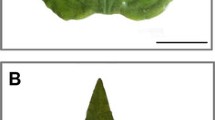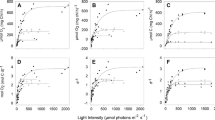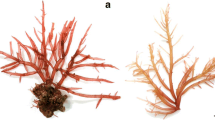Summary
The submersed aquatic macrophyte Littorella uniflora was grown under 50 and 300 μmol m−2 s−1 photosynthetically active radiation (PAR) (low and high PAR regimes) but identical sediment CO2 supply (1.0 mol m−3). The interactions between plant morphology, whole plant CO2 and O2 exchange, CAM activity, [CO2] i and [O2] i have been investigated in comparison with in vitro CO2 and PAR response characteristics (using 1 mm leaf sections). In terms of morphology, high-PAR-grown plants were smaller and leaves contained less chlorophyll, although root growth was proportionally larger. Gas exchange fluxes over roots and shoots of intact plants were similar in direction under the two PAR regimes, with the majority of CO2 uptake via the roots. Photosynthetic O2 evolution from intact plants was greater in high-PAR-grown L. uniflora (2.18 compared with 1.49 μmol O2g−1 fresh weight h−1 for the low PAR regime). Although net daytime CO2 uptake was similar for both PAR regimes (0.79 and 0.75 μmol g−1 fwt h−1), net dark CO2 uptake was at a higher rate (0.92 compared with 0.52 μmol CO2 g−1 fwt h−1), and dark fixation (as malic acid) was threefold greater in high PAR plants (ΔH+ 117 compared with 42 μmol H+ g−1 fwt). Comparison of dark CO2 uptake with dark fixation suggested that much of the CO2 fixed at night and regenerated during the day may be respiratory in origin (60% low PAR plants, 71% high PAR plants). Regeneration of CO2 from CAM could account for 62% of daytime CO2 supply in low PAR plants and 81% in high PAR plants. [CO2] i values (ranging from 0.42 to 1.03 mol m−3) were close to or above the concentration required to saturate photosynthesis in vitro (0.5 mol m−3) under both PAR regimes, and combined with the low [O2] i (2.6–4.3 mol m−3) should have suppressed photorespiration. However, PAR inside leaves would have been well below the in vitro light saturation requirement (850–1000 μmol m−2 s−1 for both treatments). Thus PAR rather than CO2 supply appeared to limit photosynthesis even in high PAR grown plants, and CAM appears to have an important role in the regulation of CO2 supply for photosynthesis in response to variation in light regime.
Similar content being viewed by others
References
Bjorkman O (1981) Responses to different quantum flux densities. In Lange OL, Nobel PS, Osmond CB, Ziegler H (eds) Physiological plant ecology I. (Encyclopedia of plant physiology, NS, vol 12A). Springer-Verlag, Berlin Heidelberg New York, pp 57–107
Boardman NK (1977) Comparative photosynthesis of sun and shade plants. Ann Rev Plant Physiol 28:355–377
Borland AM, Griffiths H (1989) The regulation of citric acid accumulation and carbon recycling during CAM in Ananas comosus. J Exp Bot 40 (210):53–60
Boston HL, Adams MS (1985) Seasonal diurnal acid rhythms in two aquatic crassulacean acid metabolism plants. Oecologia 65:573–579
Boston HL, Adams MS (1986) The contribution of crassulacean acid metabolism to the annual productivity of two aquatic vascular plants. Oecologia 68:615–622
Boston HL, Adams MS, Pienkowski TP (1987a) Utilization of sediment CO2 by selected North American isoetids. Ann Bot 60:485–494
Boston HL, Adams MS, Pienkowski TP (1987b) Model of the use of root-zone CO2 by selected North American isoetids. Ann Bot 60:495–503
Clapham AR, Tutin TG, Warburg GF (1981) Excursion flora of the British Isles. Cambridge University Press
Dennison WC, Alberte RS (1982) Photosynthetic responses of Zostera marina L. (Eelgrass) to in situ manipulations of light intensity. Oecologia 55:137–144
Den Hartog G, Segal C (1964) A new classification of the waterplant communities. Act Bot Neerl 13:367–393
Farmer AM (1987) Photosynthetic adaptation in Lobelia dortmanna and other isoetids. Photosynthetica 21 (1):51–55
Farmer AM, Spence DHN (1987) Environmental control of the scasonal growth of the the submersed aquatic macrophyte Lobelia dortmanna New Phytol 106:289–299
Farmer AM, Maberley SC, Bowes G (1986) Activities of carboxylation enzymes in freshwater macrophytes. J Exp Bot 37 (183):1568–1573
Griffiths H (1988) Crassulacean acid metabolism. A re-appraisal of physiological plasticity in form and function. Adv Bot Res 15:347–350
Groenhof AC, Smirnoff N, Bryant JA (1988) Enzymic activities associated with the ability of aerial and submerged forms of Littorella uniflora (L.) Aschers to perform CAM. J Exp Bot 39 (200):353–361
Hartman RT, Brown DL (1967) Changes in internal atmosphere of submersed vascular hydrophytes in relation to photosynthesis. Ecology 48 (2):252–258
Hohorst HJ (1965) L-(−)-Malate. Determination with malic dehydrogenase and DNP. In: Bergmeyer HU (ed) Methods of enzymatic analysis. Academic Press, New York London, pp 328–332
Keeley JE, Busch G (1984) Carbon assimilation characteristics of the aquatic CAM plant, Isoetes howellii. Plant Physiol 76:525–530
Keeley J, Morton B, Babcock B, Castillo P, Fish B, Jerauld E, Johnson B, Landre Lum H, Miller C, Parker A, Van Steenwyk G (1981) Dark CO2 fixation and diurnal malic acid fluctuations in the submerged-aquatic Isoetes storkii Oecologia 48:332–333
MacFarlane JJ, Raven JA (1989) Quantitative determination of the unstirred layer permeability and kinetic parameters of RUBISCO in Lemanea mamillosa. J Exp Bot 40 (212): 321–327
Madsen TV (1985) A community of submerged aquatic CAM plants in Lake Kalgaard, Denmark. Aquat Bot 23:97–108
Madsen TV (1987a) Interactions between internal and external CO2 pools in the photosynthesis of the aquatic CAM plants Littorella uniflora (L.) Aschers and Isoetes lacustris L. New Phytol 106:35–50
Madsen TV (1987b) Sources of inorganic carbon acquired through CAM in Littorella uniflora (L.) Aschers. J Exp Bot 38:367–377
Madsen TV (1987c) The effect of different growth conditions on dark and light carbon assimilation in Littorella uniflora. Physiol Plant 70:183–188
Möllering H (1985) Citrate. Determination with citrate lyase, MDH and LDH In: Bergmeyer HU (ed) Methods in enzymatic analysis, 3rd edition, vol VII. Academic Press, New York London, pp 2–12
Nobel PS (1982) Interaction between morphology, PAR interception, and nocturnal acid accumulation in cacti. In: Ting IP, Gibbs M (eds) Crassulacean acid metabolism, American Society of Plant Physiologists, Baltimore Maryland USA, pp 260–277
Nobel PS, Hartsock TL (1983) Relationship between photosynthetically active radiation, nocturnal acid accumulation, and CO2 uptake for a crassulacean acid metabolism plant, Opuntia ficusindica. Plant Physiol 71:71–75
Osborne BA, Raven JA (1986) Light absorption by plants and its implications for photosynthesis. Biol Rev 61:1–61
Osmond CB (1981) Photorespiration and photoinhibition. Some implications for the energetics of photosynthesis. Biochim Biophys Acta 639:77–98
Raven JA, Handley LL, Macfarlane JJ, McInroy S, McKenzie L, Richards JH, Samuelsson G (1988) The role of CO2 uptake by roots and CAM in acqusition of inorganic C by plants of the isoetid life-form: a review, with new data on Eriocaulon decangulare L. New Phytol 108:125–148
Richardson K, Griffiths H, Reed ML, Raven JA, Griffiths NA (1984) Inorganic carbon assimilation in the isoetids, Isoetes lacustris L. and Lobelia dortmanna L. Oecologia 61:115–121
Robe WE, Griffiths H (1988) C3 and CAM photosynthetic characteristics of the submerged aquatic macrophyte Littorella uniflora: Regulation of leaf internal CO2 supply in response to variation in rooting substrate inorganic carbon concentration J Exp Bot 39:1397–1410
Roelofs JGM, Schuurkes JAAR, Smits AJM (1984) Impact of acidification and eutrophication on macrophyte communities in soft waters. II. Experimental studies. Aquat Bot 18:389–411
Sand-Jensen K (1978) Metabolic adaptation and vertical zonation of Littorella uniflora (L.) Aschers. and Isoetes lacustris L. Aquat Bot 4:1–10
Sand-Jensen K, Prahl C (1982) Oxygen exchange with the lacunae and across leaves and roots of the submerged macrophyte, Lobelia dortmanna L. New Phytol 91:103–120
Sand-Jensen K, Prahl C, Stokholm H (1982) Oxygen release from roots of submerged aquatic macrophytes. Oikos 38:349–354
Segal IH (1975) Enzyme Kinetics. John Wiley & Sons, New York
Smith FA, Walker NA (1980) Photosynthesis by aquatic plants: effects of unstirred layers in relation to assimilation of CO2 and HCO sup-inf3 and to carbon isotope discrimination. New Phytol 86:245–259
Smith WG, Boston HL, Adams MS (1985) A preliminary study of the source and fate of carbon acquired via CAM in Littorella uniflora var. americana (Fern.) G1. J Freshwater Ecol 3(2):203–209
Søndergaard M (1979) Light and dark respiration and the effect of the lacunal system on refixation of CO2 in submerged aquatic plants. Aquat Bot 6:269–283
Søndergaard M, Sand-Jensen K (1979a) Carbon uptake by leaves and roots of Littorella uniflora (L.) Aschers. Aquat Bot 6:1–12
Søndergaard M, Sand-Jensen K (1979b) The delay in 14C fixation rates by three submerged macrophytes. A source of error in the 14C technique. Aquat Bot 6:111–119
Sorrell BK, Dromgoole FI (1986) Erros in measurements of aquatic macrophyte gas exchange due to oxygen storage in internal airspaces. Aquat Bot 24:103–114
Spalding MH, Schmitt MR, Ku JB, Edwards GE (1979) Crassulacean acid metabolism and diurnal variations of internal CO2 and O2 concentrations in Sedum praealtum DC. Plant Physiol 63:738–743
Spence DHN (1967) Factors controlling the distribution of freshwater macrophytes with particular reference to the lochs of Scotland. J Ecol 55:147–170
Spence DHN, Crystal J (1970) Photosynthesis and zonation of freshwater macrophytes. I. Depth distribution and shade tolerance. New Phytol 69:205–215
Szmeja J (1987) The ecology of Lobelia dortmanna L. III. The plasticity of individuals along a gradient of increasing depth in oligotrophic lakes. Ekol Polska 35 (3–4):545–558
Westlake DF (1978) Rapid exchange of oxygen between plant and water. Verh Int Ver theor and Limnol 20:2363–2367
Author information
Authors and Affiliations
Rights and permissions
About this article
Cite this article
Robe, W.E., Griffiths, H. Photosynthesis of Littorella uniflora grown under two PAR regimes: C3 and CAM gas exchange and the regulation of internal CO2 and O2 concentrations. Oecologia 85, 128–136 (1990). https://doi.org/10.1007/BF00317353
Received:
Accepted:
Issue Date:
DOI: https://doi.org/10.1007/BF00317353




